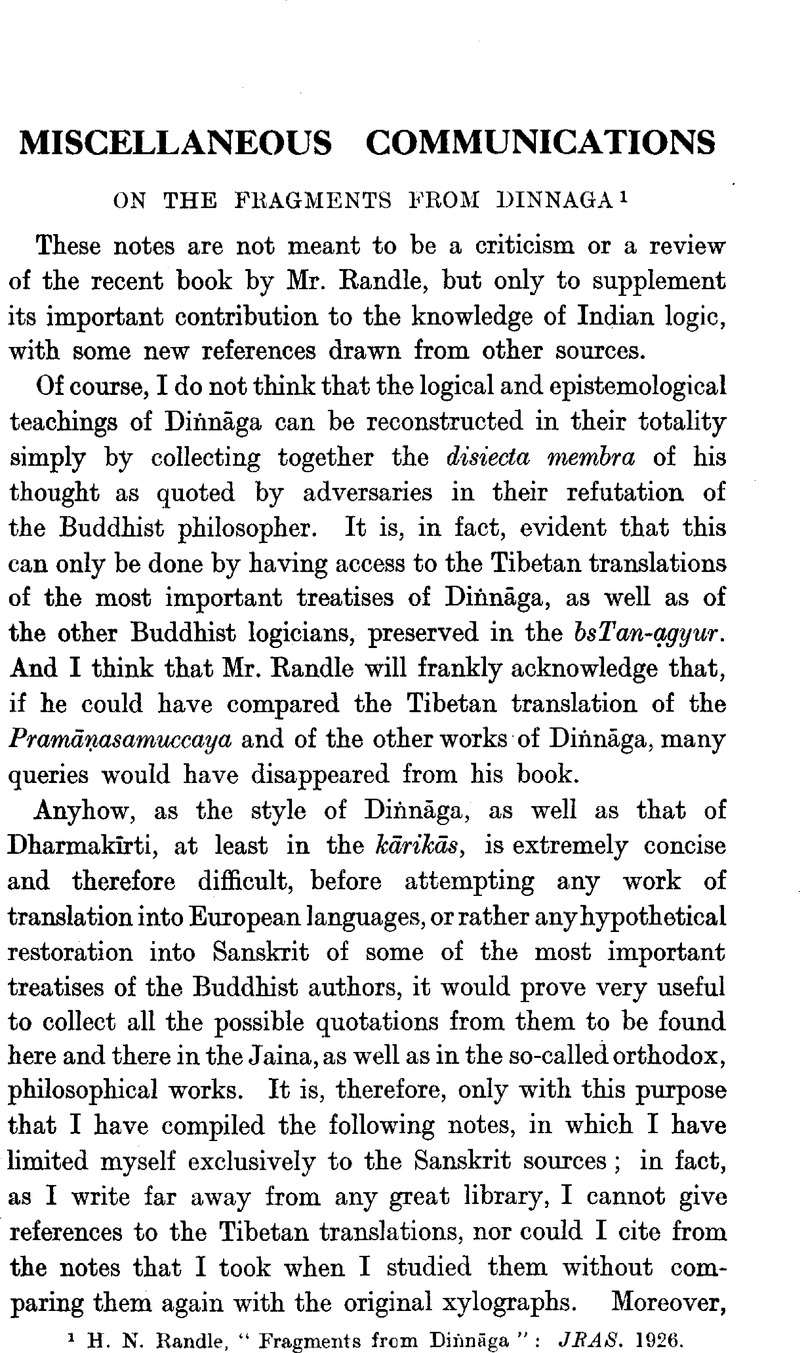No CrossRef data available.
Published online by Cambridge University Press: 15 March 2011

page 378 note 1 On Vidyānandi or Vidyānanda—both forms can be found—cf. Vidyābhūṣaṇa, , History of Indian Logic, p. 186Google Scholar, and the introduction to the edition of the Aṣṭasāhasrī by Vaṃśīdhara, , Bombay (in the collection Gandhī-nātharaṅgajī-Jainagmnthamālā, 1915)Google Scholar. The commentary by Vidyānandi on the Yuktyanuśāsana seems to be unknown to Vidyābhūṣaṇa, although it is a very important work. It is printed in the Māṇikacandadigambarajainagranthamālā (No. 15), Bombay, 1920Google Scholar.
page 378 note 2 Edited by , Vaṃśīdhara, Bombay, Nirṇaya-Sāgara, 1912Google Scholar. This work, which is certainly one of the greatest treatises on Indian logic, seems to have been inaccessible to Vidyābhūṣaṇa, who refers only to some MSS. of it (op. cit., p. 194). The Śloka saṃhṛtya sarvataś cintām, etc., is quoted also by Vidyānandi in his Pramāṇaparīṣā (in Sanātanajaina-granthamālā, Benares, 1914, No. 9, p. 54)Google Scholar.
page 379 note 1 The Āptaparīkṣā has been edited in the Sanātanajainagranthamālā, Benares, 1913Google Scholar. Vidyābhūṣaṇna simply quotes its title, but seems not to have seen this work (op. cit., p. 187).
page 379 note 2 Here also there is the reading: tad yuktam in (c), which has been accepted by the Sarvadarśanasaṃgraha, and the couplet is equally attributed to the Sautrantikās.
page 380 note 1 His opinion has been accepted by ProfessorKeith, , Indian Logic and Atomism, p. 28Google Scholar.
page 381 note 1 JBORS., vol. xii, p. iv, p. 587 ff.
page 381 note 2 Cordier suggests: codyanyāya: Stcherbatsky, , Erkenntnistheorie und Logik nach der Lehre der späteṛen Buddhisten, p. 257Google Scholar, quotes this same work under the name: codanānāmaprakararṇa. Though I have found quotations from this treatise of Dharmakīrti, I do not remember to have met with any passage in which the title itself is given. One codanā is cited, it is true, by Vidyānandi, in his Pramāṇaparīkṣä, p. 78Google Scholar; but the quotation which follows is taken from chapter ii, Codanāsūtra of the Ślokavārttika by Kumärila, vv. 62, 63 (p. 65 of the “Chowkhamba” edition). [Perhaps the title is codanā-naya = rtsod-paẖi-rigs-pa.—F. W. T.]
page 382 note 1 Cf. Vidyābhūṣaṇa, op. cit., p. 124.
page 383 note 1 The ![]() Vādavidhi is quoted by Dinnāga himself in the commentary on the first kārikā of his Nyāyadvāra.
Vādavidhi is quoted by Dinnāga himself in the commentary on the first kārikā of his Nyāyadvāra.
The other two titles have been restored by Vidyābhūṣaṇa as vādamārga and vādakauśala; vādamārga is very hypothetical, vādakauśala is wrong: it should be vādahṛdaya. Cf. the Upāyahṛdaya attributed to Nāgārjuna.
page 383 note 2 Art. cit., p. 590.
page 386 note 1 So Shen-t'ai; but, in fact, only the first and third members of the triad are contradictory (viruddha); the middle one is inconclusive, anaikāntika.
page 388 note 1 Tatra refers to the sādhya: the moon is asādhāraṇa because there is no other object which has the same attributes as the moon; because of its being asādhāraṇa it is not possible to find an example (sādharmyāt dṛṣṭānta), and therefore the anumāna is impossible.
page 389 note 1 In all this long discussion Uddyotakara is refuting Dinnāga: a comparison with the Tibetan translation of his works will ascertain how many fragments from him are quoted, in a more or less altered form, by the great naiyāyika. And it is important to see how in later logicians Dinnāga takes the second place, while all the criticism is directed against Dharmakīrti; in fact, in the Jaina nyāya treatises, in Vācaspati himself, in Jayanta, in Varadarāja, etc., the quotations from Dinnāga are very few compared with those from Dharmakīrti.
page 390 note 1 [Presumably the context forbids a reference to Udayana, who is often cited by the title Ācārya.—F. W. T.]